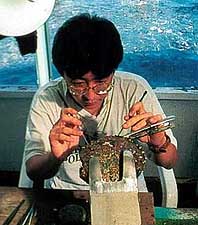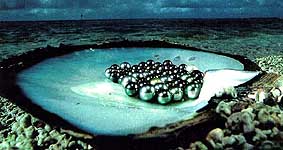The black pearl oyster of the Tuamotu atoll is about four
times larger than the size of the Japanese akoya pearl oyster, which
actually produces most of the pearls in the world. But black pearls are rarer,
thicker and bigger. They are also richer in what is called ‘orient’ which
is the reflection of the light beneath the surface of the pearl. This makes
the lustre more luxuriant. Even the colours are more various. Unusual colours
such as silver grey, obsidian (a dark colour, nearly black), sometimes white,
and occasionally green pearls are found. These green pearls are referred to as
‘peacocks’ and are raised in slightly cooler waters in the Gambier
Islands. Only the black tipped oyster from French Polynesia will yield these
rare pearls.
 A
‘grafting operator’ performs the necessary surgery to generate a pearl
A
‘grafting operator’ performs the necessary surgery to generate a pearl
Most Japanese oysters are maricultured, which means they
are actually born in a hatchery where egg and sperm are artificially combined.
But in the Tuamotus, the natural lagoon is the true parent of the oysters, and
here they spawn naturally. In this particular lagoon, the oysters act as
barometers, which register the health of the environment. If, for any reason,
the lagoon declines, so do the oysters, since they require temperatures of
about 75 degrees F and clear, unpolluted water. The egg and sperm drift as the
lagoon rises and falls with the tide, then combine to produce a larva. Such is
the romantic life of an oyster allowed the freedom of nature.
The pearl farmer, however, is a model of patience and
ingenuity. He uses plastic garlands suspended in the lagoon to provide an
anchorage for the drifting pinhead size larvae. In a few months, each garland
is choked with little oysters. They soon grow to the size of silver dollars.
At six months the oysters are placed in hanging baskets where they will be
left to grow for another year and a half. Then the oysters are removed, and
wedged open, one by one. With surgical precision, a ‘grafting operator’
will make a slit with a scalpel near the oyster’s gonad, and insert a
snippet of mantle tissue, followed by a nucleus - a bead carved from the shell
of an American fresh water mussel. The mantle tissue forms a sac where
‘nacre’, the pearlescent substance that coats the nucleus to form a pearl,
is generated. After this ‘surgery’, the oysters will be returned to the
lagoon. It will be three years before the pearls will be ready for harvest.
 Black
pearls from French Polynesia. Rarer and bigger, these are the true treasures
from the Tuamotu Archipelago
Black
pearls from French Polynesia. Rarer and bigger, these are the true treasures
from the Tuamotu Archipelago
And what a harvest it is! Thousands of gleaming black
pearls end up in the sorting room, each plucked from the maw of an oyster.
They will be graded for quality, then sold in the USA, Europe, and Japan.
There are more than 500 black pearl oyster farms throughout Polynesia. Some
are large, but many are little more than a boat, a few lines of oysters, a
scuba tank, a shed, and a determined pearl farmer and his family. Even on this
tiny scale, the black pearl is a prized treasure, indeed. For these pearls are
not accidental gifts from the sea. They are a product of a complicated
partnership between humans and oysters.